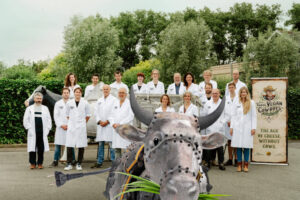Cora Poniwerski is head of marketing and communications at Carbon Count, a management platform for soil carbon projects based in Sydney, Australia.
The views expressed in this guest commentary are the author’s own and do not necessarily represent those of AFN.
The recent report by the UN Intergovernmental Panel on Climate Change (IPCC) reconfirms: the window to save ourselves from the worst effects of climate change is rapidly closing. Impacts from dramatic shifts in climate are likely to overwhelm Australia’s and the world’s ability to adapt in the near future. Climate action in the form of radical transformation is needed.
A gloomy outlook indeed. But all is not lost.
A rapidly growing number of researchers, scientists, and agricultural experts state that a change in agricultural practices supported by sound policy can help the world and our nation turn things around. This is the conclusion of a group of agricultural thought leaders who participated in a recent roundtable discussion which forms the basis of Carbon Count’s latest white paper, “Change at Our Feet.”
And they are not alone. Our government, too, commends the agricultural sector for being amongst those doing most of the ‘heavy lifting’ in cutting our nation’s greenhouse gas (GHG) emissions. Agriculture is estimated to generate around 13% of Australia’s GHG emissions; at the same time, carbon sequestration to soil and vegetation is considered one of the greatest hopes for achieving our emissions reduction targets in Australia’s net-zero plans.
Clearly, Australian primary producers have a major role to play on both sides of the net-zero coin. What is yet to be widely recognized however, is not just the might of the agricultural sector – but the power that our agricultural lands hold.
More than ‘just’ our nation’s breadbasket, soil is Earth’s most powerful regulator of atmospheric heating and, together with vegetation, our most promising agent for natural decarbonization. As the caretakers and guardians of the soil, farmers play a pivotal role in Australia achieving net-zero emissions.
Change at our feet
Australia’s long-term emissions reduction strategy, “The Plan to Deliver Net Zero: The Australian Way” [PDF], depicts a roadmap that depends solely on voluntary industry engagement and relies on exporting energy resources – more specifically, fossil fuels – as an economic driver. It aims to reach emissions targets by focusing strongly on technological development and prioritizing technologies that will help our nation cut emissions while creating jobs and growing the economy.
The “Change at Our Feet” roundtable saw 10 members from various sectors of the agricultural industry join heads to explore the role that Australian agriculture can play in working through “the Australian way” to net zero, where opportunities and impediments for the agricultural industry’s role in climate change and climate action were evaluated.
So: what became apparent during the discussion?
- A strong need for appropriate policy support and clear financial frameworks to enable and encourage timely uptake of emission mitigation practices, and participation of the entire agricultural sector and farms of all sizes in this; scalable legislative frameworks that reward pioneers; more educational support to ensure good land stewardship; and the need for our industry to speak with one voice to accelerate consolidated climate action.
- A warning against the industry communicating with too many voices; creating the impression of a system in disarray, as has been seen in recent forays in the media. Such activity sets back industry uptake at a time when fast climate action is most needed.
- Continuous research is crucial but should not stand in the way of uptake of carbon sequestration activities. Information will never be perfect, no matter how much research is undertaken. Improvements will, and can, be expected along the journey of uptake.
- If we become successful at creating the necessary tools and frameworks to achieve large-scale industry participation, our nation can still position itself as a global leader in emissions mitigation, leading the way to a better future by protecting our unique landscape and industries.
- Commercial viability is key. Ultimately, practice change must be considered in the commercial reality that farm businesses exist in. Farms are commercial enterprises; climate-positive activities must be commercially viable, and easy to set-up and maintain.
- Supporting farmers not just in the measurement of carbon, but also for their transition to more regenerative carbon sequestration practices, was considered essential by the industry experts in order to encourage rapid uptake by the rural sector to meet industry and government targets.
Establishing “the Australian way” to net-zero by 2050 has been a big step in the right direction by our government. The true challenge now lies in creating systems that are scalable and measurable, with as few barriers as possible, that provide well-structured support and attractive incentives to encourage large-scale and timely adoption.
To further accelerate positive agricultural change and enable the sector to continue to excel, we need to create strong policy frameworks that foster and fund our regenerative agriculture early adopters, innovators, and other agricultural leaders, to publicly steer a narrative that shapes farming policy, practice, and public perception.
The result of our collective efforts will be improved landscape health, the creation of a more prosperous agricultural community, and ecosystem diversity, which will benefit us all.




